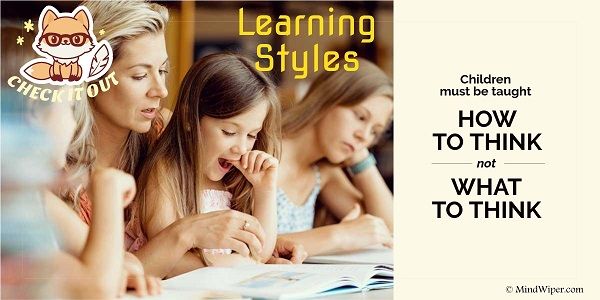Learning style is an individual approach to learning methodologies based on preference, weakness, and strength; individuals can adopt one or more learning styles based on the situation, criteria, and ease of understanding of the selected topic.
You may be tired of learning something fairly simple, or you may be tired to teach someone a simple explanation, this may happen due to improper alignment of learning styles.
Best learning methodologies are based on precise attention, methods of remembering, and use of thinking to learn; while someone may prefer to learn intuitively.
Understanding learning styles can enable individuals to adopt the best learning approach suitable for them to learn or teach someone else.
What are the Learning Styles?
There are many different learning styles models, the report on reviewing the literature of learning styles developed by a Frank Coffield, David Moseley, Elaine Hall and Kathryn Ecclestone; identified 71 different learning styles.
Here is the list of popular learning styles,
Active Learner
They are those who tend to learn through continuous physical activities, experiment, and trying out the things to learn.
Active learners retain and understand information best by doing group discussion, explaining others or applying the information either through imagination or through some real time experiment.
They tend to learn fast, they might not like long theoretical lectures; instead, they focus to learn through active involvement. STEM students & professionals are often considered as an active learner.
Reflective Learner
Reflective learners are those who prefer to learn in solitude, they find it hard to learn in a group as active learners do.
They prefer to think & manipulate the information quietly before remembering something new. Reflective learners are considered slow learner, but they exhibit high analytical skills, imagination and evaluation skills.
Reflective learners prefer to memorize after understanding the topic in detail, they prefer short notes of the selected subject to memorize.
They are the one who likes to be self-taught, and they possess a high level of rational thinking, judgmental capability, and cognitive skill.
Even though reflective learners are considered to be slow, their practice of reflective learning can make the habit of reflective learning an intuition; and then they tend to learn fast, effectively, and efficiently.
Reflective learners are hard to manipulate by others as they are good rational thinkers.
Sensory Learner
Sensing learners tend to say, “How does it relate to the real world.” They prefer concrete, procedural and practical information.
Sensory learners take advantage of sensory inputs such as image, sound or touch received through sensory organs and they tend to relate the information to the real world sensory input they already know.
Sensory learners are very patient while learning, they are well versed in practical works, and they are good at memorizing facts; but they don’t like complication in a difficult situation such as new educational resources or pattern in an examination.
Intuitive Learner
Intuitive learners are those who like to think thoroughly first by applying their intuition to analyze & understand conceptual, theoretical, and innovative information.
They focus on meaning, ideas, possibilities, connection, and abstract information to discover relationship & connection between information through their intuition.
Intuitive learners are easy in grasping abstraction, mathematical deduction, and philosophical interpretation. They like innovation; dislike repetition and memorization that involve facts and repeated calculation.
Visual Learner
Visual learners prefer graphs, diagrams, pictorial models to learn. They can remember and learn efficiently when they see pictures, diagrams, flowcharts, timelines, videos, and demonstrations.
If you are a visual learner, try to find diagrams, flow chart, videos or any kind of pictorial demonstration of your course materials, use color codes to mark your notes and make concept listing key diagrams.
Visual learning style is considered to be a slow method as most of the reading materials are found in text form and learners often take time to learn through visualization and pictorial representation
Verbal Learner
Verbal learners prefer to hear or read information, they can remember best from words, either in written or in spoken form. They prefer explanation, formulas, and outlines.
If you are a verbal learner, make summaries or outlines of course material and try to remember or discuss in a group for effective learning.
Sequential Learner
As the name suggests, sequential learners prefer to learn in a sequential fashion, i.e. they learn step by step in a logical and orderly manner. After learning each step in an orderly manner, they prefer to put together the details to understand how the big picture emerges.
Sequential learners progress steadily rather than quickly, and they prefer detail analysis and understanding or each step. If you are a sequential learner, study and make notes in an orderly manner to try to grasp the information when all the steps are complete.
Global Learner
Global learners prefer holistic and systematic approach; they focus on the big picture before knowing the steps in detail.
Global learners are big-picture thinkers. They tend to learn in large jumps, absorbing material randomly without considering a connection between information and finally they get it.
Global learners are the quick learner and they like to make conceptual leaps and like to synthesize information creativity. They can solve big problems quickly in a novel way as they grasp information quickly on a big scale.
Characteristics of Learning Styles
According to the revised model of learning methods by Richard M. Felder, there are four dimensions of learning styles and this will tell you how strongly you fit into two categories of learning styles.
Preferred Learning Style | Corresponding Teaching Style | ||
Sensory |
Perception | Concrete |
Content |
Intuitive | Abstract | ||
Visual |
Input | Visual |
Presentation |
Verbal | Verbal | ||
Active |
Processing | Active |
Participation |
Reflective | Passive | ||
Sequential |
Understanding | Sequential |
Perspective |
Global | Global | ||
Find out your preferred learning or teaching dimensions; for example, Sensory or Intuitive learners prefer to learn through perception and a teacher should teach the content concretely or abstractly to Sensory or Intuitive Learners.

Ashim, the Founder of MindWiper, loves to learn, share, and educate various dimensions of life skills development. After graduating with an engineering degree, he worked with major ICT industries in India and finally he followed his dream to integrate technology for Cognitive Skills & Life Skills Development.

